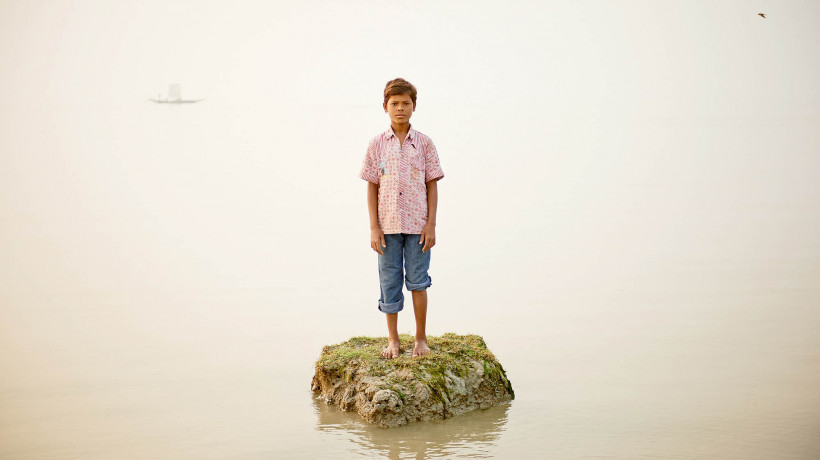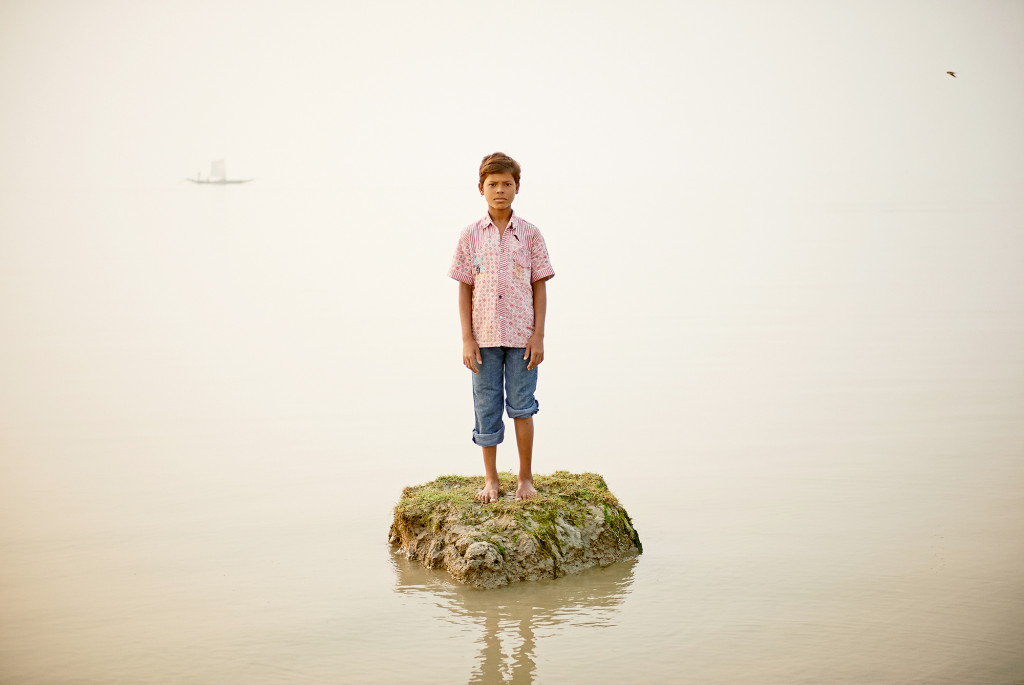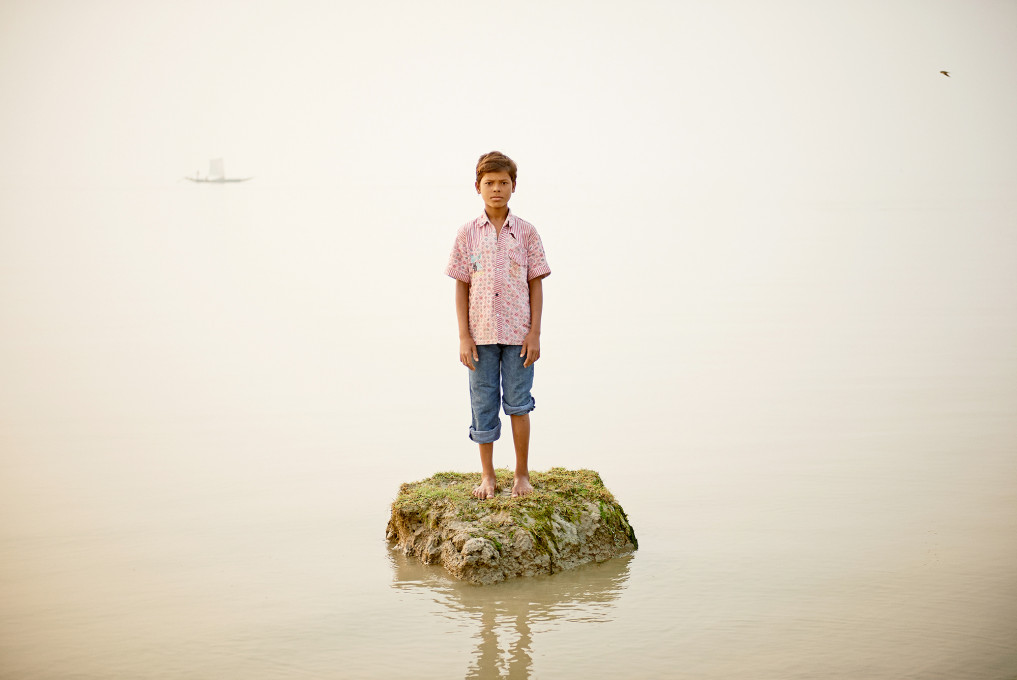Daesung Lee, a South Korean photographer, now living and working in France, initially linked photography with travel and the preservation of memories. Visiting diverse locations, getting to know people and their lives led him to become aware of the potential of photography in addressing wider social issues. His work has ever since been irrevocably intertwined with the latter, driving him to leave his job in the commercial industry and dedicate himself to independent photo series.
Over the last decade, his projects have addressed topics such as sulphur collectors in Indonesia (Sulphur Collectors, 2009) and coal collectors in India (Jharia: The Land of Coal Fire, 2010); raw materials serving the western world in its increasingly rapid and luxurious development, and pushing the original locations of origin into misery and self- destruction. By cutting into just a fraction of the great mass of social injustice, Lee triggered a chain reaction took place, where every story leads to the next. Heavy industries, among others, cause global pollution, which is indirectly responsible for the raising of ocean levels (Vanishing Island, 2011). At the same time, and paradoxically, green landscapes of the continents are drying out (Futuristic Archaeology, 2014). However, both phenomena are forcing people to live outside their original geographic locations.
%22%20transform%3D%22matrix(4%200%200%204%202%202)%22%20fill-opacity%3D%22.5%22%3E%3Cellipse%20fill%3D%22%23f4efff%22%20rx%3D%221%22%20ry%3D%221%22%20transform%3D%22rotate(91.2%2083%20118)%20scale(41.5526%20230.06084)%22%2F%3E%3Cellipse%20fill%3D%22%23b2c35e%22%20cx%3D%2235%22%20cy%3D%22139%22%20rx%3D%22255%22%20ry%3D%2255%22%2F%3E%3Cellipse%20fill%3D%22%23fff%22%20rx%3D%221%22%20ry%3D%221%22%20transform%3D%22rotate(-87.5%20130.5%20-117.7)%20scale(24.39517%2040.41137)%22%2F%3E%3Cellipse%20fill%3D%22%23afacc3%22%20cx%3D%2249%22%20cy%3D%2270%22%20rx%3D%2257%22%20ry%3D%2211%22%2F%3E%3Cellipse%20fill%3D%22%23b6b2c9%22%20rx%3D%221%22%20ry%3D%221%22%20transform%3D%22matrix(-32.07222%20-4.67171%202.26844%20-15.57329%20183.8%2085.3)%22%2F%3E%3Cellipse%20fill%3D%22%23eeeaff%22%20cx%3D%22246%22%20cy%3D%2286%22%20rx%3D%2232%22%20ry%3D%2210%22%2F%3E%3Cellipse%20fill%3D%22%23fff%22%20cx%3D%22239%22%20cy%3D%2210%22%20rx%3D%2232%22%20ry%3D%2232%22%2F%3E%3Cpath%20fill%3D%22%23e8e7ef%22%20d%3D%22M118.7%2080.8l30.2-26.2%2014.4%2016.6-30.2%2026.2z%22%2F%3E%3Cellipse%20fill%3D%22%23aeabc3%22%20cx%3D%2216%22%20cy%3D%223%22%20rx%3D%2234%22%20ry%3D%229%22%2F%3E%3Cellipse%20fill%3D%22%23b8c671%22%20cx%3D%229%22%20cy%3D%2284%22%20rx%3D%2263%22%20ry%3D%225%22%2F%3E%3Cellipse%20fill%3D%22%23dedee6%22%20cx%3D%2218%22%20cy%3D%2244%22%20rx%3D%22224%22%20ry%3D%2218%22%2F%3E%3Cellipse%20fill%3D%22%23bab9c0%22%20rx%3D%221%22%20ry%3D%221%22%20transform%3D%22matrix(37.02432%2011.07731%20-3.11013%2010.39515%2083.3%2074.7)%22%2F%3E%3C%2Fg%3E%3C%2Fsvg%3E)
Daesung Lee: from the series Futuristic Archaeology, 2014. Courtesy of the artist. %22%20transform%3D%22matrix(4%200%200%204%202%202)%22%20fill-opacity%3D%22.5%22%3E%3Cellipse%20fill%3D%22%23fff%22%20rx%3D%221%22%20ry%3D%221%22%20transform%3D%22rotate(176.7%2069.7%205.3)%20scale(185.74035%2050.86357)%22%2F%3E%3Cellipse%20fill%3D%22%23050505%22%20rx%3D%221%22%20ry%3D%221%22%20transform%3D%22matrix(-.3179%20-35.02182%20254.9895%20-2.31457%20108.6%20143.5)%22%2F%3E%3Cellipse%20fill%3D%22%23fff%22%20cx%3D%2284%22%20rx%3D%22148%22%20ry%3D%2222%22%2F%3E%3Cellipse%20fill%3D%22%23040404%22%20cx%3D%2265%22%20cy%3D%22159%22%20rx%3D%2238%22%20ry%3D%2222%22%2F%3E%3Cellipse%20fill%3D%22%234e4e4e%22%20rx%3D%221%22%20ry%3D%221%22%20transform%3D%22matrix(-.01597%2017.69111%20-207.18545%20-.18706%2094.6%20103.9)%22%2F%3E%3Cellipse%20fill%3D%22%238b8b8b%22%20rx%3D%221%22%20ry%3D%221%22%20transform%3D%22matrix(238.16046%20-6.32156%20.5483%2020.65691%20160.2%2055.8)%22%2F%3E%3Cellipse%20fill%3D%22%235a5a5a%22%20rx%3D%221%22%20ry%3D%221%22%20transform%3D%22matrix(65.89636%20-27.029%207.47444%2018.22259%20245%2089)%22%2F%3E%3Cellipse%20fill%3D%22%236d6d6d%22%20rx%3D%221%22%20ry%3D%221%22%20transform%3D%22matrix(50.49911%203.25533%20-.37482%205.81447%20165.5%20111.5)%22%2F%3E%3Cellipse%20fill%3D%22%23949494%22%20cx%3D%22249%22%20cy%3D%2237%22%20rx%3D%2249%22%20ry%3D%2212%22%2F%3E%3Cellipse%20fill%3D%22%23525252%22%20cx%3D%225%22%20cy%3D%2294%22%20rx%3D%2231%22%20ry%3D%2219%22%2F%3E%3Cpath%20fill%3D%22%239d9d9d%22%20d%3D%22M0%2038h207v21H0z%22%2F%3E%3Cpath%20fill%3D%22%23878787%22%20d%3D%22M194.5%2095.5l-75.2-17%20112-6.3L186%2094.6z%22%2F%3E%3C%2Fg%3E%3C%2Fsvg%3E)
Daesung Lee: from the series Jharia: The Land of Coal Fire, 2010. Courtesy of the artist. %22%20transform%3D%22matrix(4%200%200%204%202%202)%22%20fill-opacity%3D%22.5%22%3E%3Cellipse%20fill%3D%22%23a3ab80%22%20cx%3D%22131%22%20cy%3D%22167%22%20rx%3D%2261%22%20ry%3D%2261%22%2F%3E%3Cellipse%20fill%3D%22%23f0f0f4%22%20rx%3D%221%22%20ry%3D%221%22%20transform%3D%22matrix(-7.7806%2056.3364%20-252.60228%20-34.88683%20137%2032.8)%22%2F%3E%3Cellipse%20fill%3D%22%23a2a2a6%22%20rx%3D%221%22%20ry%3D%221%22%20transform%3D%22matrix(50.9282%20-33.24262%2023.7636%2036.4062%20241.7%20153.2)%22%2F%3E%3Cellipse%20fill%3D%22%23a9b475%22%20rx%3D%221%22%20ry%3D%221%22%20transform%3D%22matrix(1.60525%20-27.14903%2041.73024%202.4674%205%20167)%22%2F%3E%3Cellipse%20fill%3D%22%23b1c356%22%20cx%3D%22125%22%20cy%3D%22151%22%20rx%3D%2223%22%20ry%3D%2231%22%2F%3E%3Cellipse%20fill%3D%22%23fff%22%20rx%3D%221%22%20ry%3D%221%22%20transform%3D%22matrix(-42.11362%2052.37878%20-18.26573%20-14.68603%2091.2%200)%22%2F%3E%3Cellipse%20fill%3D%22%23e7e6ea%22%20cx%3D%2246%22%20cy%3D%22101%22%20rx%3D%2249%22%20ry%3D%2249%22%2F%3E%3Cellipse%20fill%3D%22%23b5b4bf%22%20cx%3D%22124%22%20cy%3D%22105%22%20rx%3D%2228%22%20ry%3D%2219%22%2F%3E%3Cpath%20fill%3D%22%23858585%22%20d%3D%22M234%20150h22v21h-22z%22%2F%3E%3Cpath%20fill%3D%22%23fff%22%20d%3D%22M148.7%2011.6l-90%2012.6L55.2.4l90-12.6z%22%2F%3E%3Cellipse%20fill%3D%22%23c3c0d2%22%20rx%3D%221%22%20ry%3D%221%22%20transform%3D%22matrix(20.32441%20-10.30424%2025.93196%2051.14902%20177.2%20163.7)%22%2F%3E%3Cpath%20fill%3D%22%23909b55%22%20d%3D%22M116%20125h24v19h-24z%22%2F%3E%3C%2Fg%3E%3C%2Fsvg%3E)
Daesung Lee: from the series On the Shore of a Vanishing Island, 2011. Courtesy of the artist. %22%20transform%3D%22matrix(4%200%200%204%202%202)%22%20fill-opacity%3D%22.5%22%3E%3Cellipse%20fill%3D%22%23faf6ff%22%20cx%3D%22118%22%20cy%3D%2223%22%20rx%3D%2264%22%20ry%3D%2264%22%2F%3E%3Cellipse%20fill%3D%22%2382903c%22%20rx%3D%221%22%20ry%3D%221%22%20transform%3D%22matrix(20.21427%2088.98482%20-45.72814%2010.38785%2024%20134.7)%22%2F%3E%3Cellipse%20fill%3D%22%23bdcf67%22%20rx%3D%221%22%20ry%3D%221%22%20transform%3D%22matrix(14.54802%20-50.73729%20137.17496%2039.3325%20196.5%20163.3)%22%2F%3E%3Cellipse%20fill%3D%22%23c4c1db%22%20cx%3D%22233%22%20cy%3D%2251%22%20rx%3D%2269%22%20ry%3D%2269%22%2F%3E%3Cellipse%20fill%3D%22%23b2aecd%22%20rx%3D%221%22%20ry%3D%221%22%20transform%3D%22rotate(-157.2%209.7%2019)%20scale(73.4284%2033.4601)%22%2F%3E%3Cellipse%20fill%3D%22%23e4e3ef%22%20rx%3D%221%22%20ry%3D%221%22%20transform%3D%22matrix(-13.04878%2016.73688%20-59.18958%20-46.1467%2088.4%2029.3)%22%2F%3E%3Cellipse%20fill%3D%22%23fafafb%22%20cx%3D%22251%22%20cy%3D%2277%22%20rx%3D%2223%22%20ry%3D%2211%22%2F%3E%3Cpath%20fill%3D%22%238a954f%22%20d%3D%22M136%20122h35v12h-35z%22%2F%3E%3Cpath%20fill%3D%22%23bebbd0%22%20d%3D%22M106%2099l75-3-11-36z%22%2F%3E%3Cellipse%20fill%3D%22%239eab5d%22%20rx%3D%221%22%20ry%3D%221%22%20transform%3D%22matrix(31.18717%20-6.45855%2013.34855%2064.4577%2034.7%20139.7)%22%2F%3E%3Cellipse%20fill%3D%22%23e2e2e6%22%20cx%3D%22133%22%20cy%3D%2230%22%20rx%3D%2247%22%20ry%3D%2247%22%2F%3E%3Cpath%20fill%3D%22%23c2cd87%22%20d%3D%22M223%20185L62%20138l3-52z%22%2F%3E%3C%2Fg%3E%3C%2Fsvg%3E)
Daesung Lee: from the series Sulfur Collectors, 2009. Courtesy of the artist.
In all four series, Lee maps the subjects in their natural environment. Sometimes he takes photographs of people at work, while on other occasions he approaches them, as if he were a local photographer who came to get a professional portrait, and their surroundings become a background for motifs directed straight at the camera. If in the first two series, the working environment of people was the one that created the atmosphere of photographs and their stories, Vanishing Island and Futuristic Archaeology focus on the living environment. The images of the inhabitants of the island in western Bengal, standing on the last remaining pieces of their land, are sufficiently eloquent without the need for the photographer to provide an additional explanation – the province itself tells us that it is disappearing. We see the layers slowly getting washed away by erosion. When the author explored the problem of soil drying in Mongolia, he came to the conclusion that there is certain type of nostalgia for the traditional nomadic life, which is preserved as a tourist souvenir, and is slowly preparing for its entry into the museum diorama, but the real problems are rarely solved. Lee addresses the archiving of history in museums as a practice that establishes itself as more important than the actual preservation of certain areas, people and ways of life in the present moment. And in order to prevent anyone from doubting his purpose, a red museum ribbon is placed in front of the photographs of an idyllic Mongolian landscape inside an actual Mongolian landscape that prevents the visitor from getting too close to this history.
Although the backdrop was never in the forefront of Lee’s projects as a concept, it ended up as the last strategy before the author withdrew from reporting essays into studio documentation (Unwanted Souvenir, 2016) and the world of dreams (The Red Forest, 2018).






